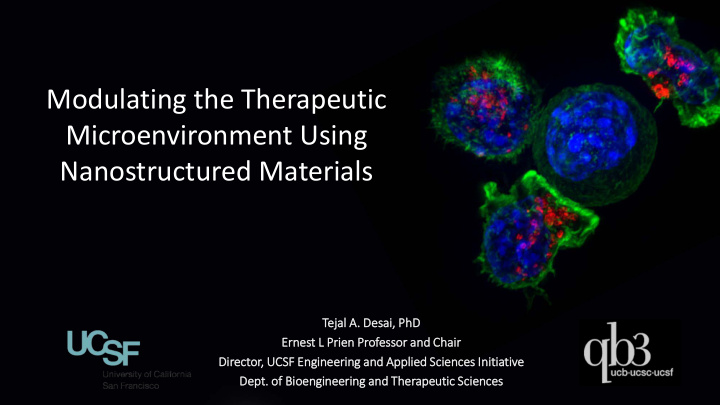



Modulating the Therapeutic Microenvironment Using Nanostructured Materials Tej ejal A l A. Des esai, i, Ph PhD Ernest st L L Pr Prien Professo essor and C nd Chair Direc ector, UCSF E F Engineer eering and nd Appl pplied ed S Scien ences I es Initiative Dept. of Bioen engineer eering a and nd T Ther herape peutic S Scien ences es
Advanced biomaterials for therapeutic delivery CANCER DIABETES HEART DISEASE PSORIASIS Size ARTHRITIS … Surface Material Shape Direct biophysical stimulation Biomolecule carrier/presenter Picture credit: Zhang, Drug Discovery Today
How can material structure Micro and Cell –Material Nanostructures Interactions modulate biologic function for therapeutic purposes? Therapeutic Systems
Desired Routes of Drug Delivery
Challenges to epithelial drug delivery 5
Revisiting the small intestine Length (m) 10 0 Small intestine 10 -2 Villi 10 -4 Enterocytes 10 -6 Microvilli 10 -8 Fox C et al., Journal of Controlled Release, 2015
Drawbacks of paracellular permeation enhancers Membrane damage and Permeation enhancer cell toxicity (red) opens tight • Chemical permeation agents junctions for increased drug induce opening of tight permeation junctions • Examples: Surfactants, chelators, and toxins Non-reversible tight • Toxicity to cells junction damage • Non-reversible tight junction opening
Opening Epithelial Barriers Sun et al. Physiological Reviews, 2017.
Topographical cues can enhance permeation of drug between tight junctions Nanostructured Diameter: 200 nm Film Height: 300 nm High Drug Permeation Drug Molecule Cells Diameter: 800 nm Height: 16 µm Low Drug Permeation Kam et al., Nanoletters, 2014; Stewart et al., Exp. Cell Res, 2017
Nanostructured microneedles enhance transdermal drug delivery Sun, et al. Physiological Reviews, 2017 Walsh, et al. Nano Lett, 2015
Nanostructured planar particles for enhanced oral delivery 200 nm diameter Fox et al., JCR 2015 Fox et al. ACS Nano 2016
Nanostructures can be tuned to facilitate permeation HD100 HD200 HD500 LD100 LD200 LD500
The process is reversible and involves remodeling of tight junctions Remove c) b) a) d 10 µ m 10 µ m 10 µ m 20 µ m 20 µ m 20 µ m ZO-1 (tight junction protein), Caco-2 nuclei, F-Actin
Paracellular or transcellular? Mechanism?
FITC-IgG present at apical cell-cell borders
TJ scaffolding protein ZO-1 shows altered morphologies upon NS film treatment Z-stack-1 Z-stack-2 Z-stack-3 Z-projection Total level keep the same reversible
CRISPR-based gene editing to visualize tight junctions Clone isolation Fluorescent protein fusion of TJP-ZO-1 Inserted allele ZO-1 Original allele mCherry Inserted allele Original allele After In Vitro barrier model screening ZO-1 proteins fused with mCherry-reporter at Endogenous ZO-1 ICC N-terminus through CRISPR mCherry-ZO1
Dynamic changes in TJs with nanostructure contact NS NS Time-Lapse Video of ZO-1 during Nanostructure Treatment (MAX Z-projection, 2 locations 1s=5mins) TEER>>1800 10-40 mins 45-75 mins
Large aggregates of ZO-1protein are formed on apical side when treated with NS film
Active interaction between aggregates and border ZO-1
NS-film treated cells have faster recovery from FRAP Photobleaching t = 300s t = 0s t = 100s t = 200s in frame NS-treated Non-treated
Junctional protein Claudin-4 colocalizes with ZO-1 aggregates Video Non-treated NS Flat endogenous mCherry-ZO-1 + AAV exogenous YFP-Cldn3, Z projection of ~1um
Using physical cues to alter tight junction permeability: implications for delivery
Harnessing nanotopographical cues for therapy Epithelial Smooth Cells Endothelia Muscle l Cells Cells Fibroblasts
Th The The Therapeutic M c Micr cro a and d Nanot otec echnol ology L Laboratory at UCSF Dr. r. Xiao H Huang ng Dr. r. Xiaoy oyu Sh Shi Dr Dr. Anna C Celli elli Dr. Camer eron N Nemeth • Mike ke Koval, l, E Emory • Thea ea Mauro, U , UCSF CSF • Bo Bo H Huang, U UCSF CSF • NIH H • NSF SF • Kimbe berl rly C Clark rke • Za Zamb mbone Ltd • SPA PARC • Eli L i Lill lly
Recommend
More recommend